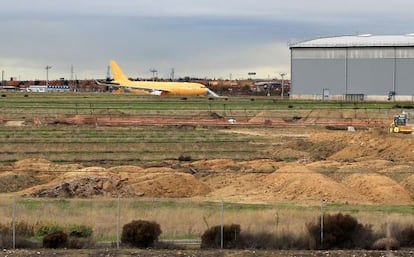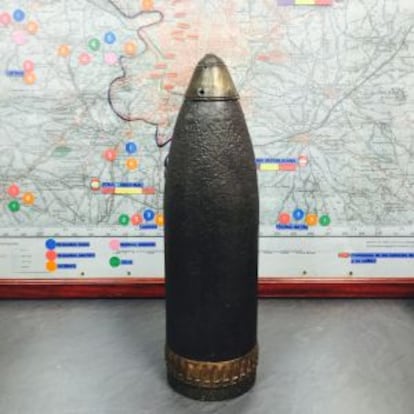Preventing a blast from the past at Airbus’s Madrid headquarters
Bomb experts are inspecting land owned by plane manufacturer after discovery of shells


The aircraft produced by Airbus, the world’s largest plane manufacturer, are designed to withstand lightning strikes, extreme temperatures, and even birds flying into their engines. But they are not built to withstand bombs – which is what was recently dug up during work to expand the company’s facilities outside Madrid.
Over the last couple of months, members of the police force’s TEDAX bomb disposal unit have been combing around 40,000 square meters of land in Getafe, a dormitory town 10 kilometers east of the capital, after an excavator unearthed an artillery shell dating back to the Civil War there.
“It was a five-inch caliber, 60-pound projectile with a range of between eight and 10 kilometers,” explain Antonio Alonso and Javier Bermúdez, two officers with 20 years’ experience in the bomb disposal unit who have covered the Madrid region one shell at a time. “It was fired by the Republicans defending Madrid during the Civil War.”
Airbus bought the land in 2013 to extend its facilities, and commissioned a survey to identify any suspicious metallic objects
Both men are experts on the Spanish Civil War (1936-1939) when Madrid was besieged by the rebel forces of General Francisco Franco. “Explosives are always live, they are designed to kill. Trinitrotoluene, the compound mostly used in them, is very stable and very powerful,” they say.
Airbus bought the Getafe land in 2013 to carry out a €42 million extension to its facilities, and commissioned a geophysical survey to identify any suspicious metallic objects that might be buried underground. So far, only one other artillery shell has been found, although the entire area has not yet been fully covered.
“This is a probability survey, it tells you that something could be there,” say the Civil Guard officers.“If it detects a metal object at three meters, then we dig down to six, as deep as we can.”
These kinds of surveys are mandatory for just about any construction work in some parts of France and Germany as a result of ordnance left by the two world wars, but this is not the case in Spain. However, the country has experienced its fair share of bomb disposal inspections over the last decade: “We call it the TEDAX economy index, reflecting the amount of building work that has gone on here. In 2005, for example, we carried out around 400 inspections.”
A spokesman for Airbus explains that the discovery of the Civil War shell has brought work to a halt in one sector, but that construction of a parking lot and a daycare center continues at the main Getafe site: “It’s the biggest factory we have, with around 9,000 to 10,000 people passing through every day. The work will continue for another two or three years.”
Meanwhile, outside, Alonso and Bermúdez continue supervising the removal of the artillery shell, and explain a little more about the history of the Battle for Madrid. “The Republican forces had six five-inch guns located on the right-hand side of the front. It is possible that these shells were fired between 1937 and 1939 from Vallecas, because howitzers were always kept protected in the rear, around 10 kilometers from the front,” says Alonso, explaining that the British-made 60-pounder dates back to World War I.
“Later, during the Russian Revolution, the British sold them to the White Russians, but the Reds won, and they then sold them on as though they were new to the Spanish Republic at an extortionate price. Then Franco captured them, and sold them to the Finnish armed forces to fight the Russians in World War II. This is a weapon that saw a lot of action.”
After the Civil War, the Spanish army carried out surveys of areas where there had been fighting. “It was led by a character named Manuel Bonilla Sánchez; he put together a handbook of weapons and ammunition used in the conflict, which is pretty much our bible.”
These experts add that Bonilla was shot in 1945 for selling weapons to the maquis, the fighters who continued resisting Franco after the end of the Civil War in 1939.
The two officers say they have had less to do since the collapse of the property sector and the economic crisis. Their busiest time was probably 2005 and 2006, when they went out nearly every day to La Finca, an upscale gated community popular with soccer players on the northwestern edge of Madrid, in an area that saw heavy fighting during the Civil War.

“We retrieved 67 155mm caliber shells from the area: they would have been fired by the Republican forces from the Moncloa district,” says Alonso. “The 155mm was also known as the 15-and-a-half, and it was the main shell used by both forces: Gran Vía, one of the streets in Madrid that was most hit by Franco’s forces, was known as 15-and-a-Half Avenue.”
Franco’s forces targeted the Telefónica building, then the city’s tallest building and located at the highest point on Gran Vía, because it was used by the Republican forces to monitor Nationalist positions on the northwestern edges of the city. Inevitably, Franco’s gunners regularly missed their target, and many shells ended up landing a couple of hundred meters behind in what is today the Plaza Vázquez de Mella, which was so badly damaged that it was eventually cleared and turned into a parking lot in 1949.
In March 2014, during renovation work on a penthouse in nearby Loreto y Chicote street, directly behind the Telefónica building, workers found an unexploded 75mm artillery shell encrusted in the roof, and promptly removed it and took it to a nearby police station, a decision that Alonso and Bermúdez describe as “reckless,” pointing out that the fuses on these artillery shells are very delicate: “It’s very easy for them to explode, even after all these years.”
In the case of areas like the Airbus site in Getafe, Alonso and Bermúdez take the shells to waste ground, closing off the area “up to around 150 meters” before detonating them.
Tu suscripción se está usando en otro dispositivo
¿Quieres añadir otro usuario a tu suscripción?
Si continúas leyendo en este dispositivo, no se podrá leer en el otro.
FlechaTu suscripción se está usando en otro dispositivo y solo puedes acceder a EL PAÍS desde un dispositivo a la vez.
Si quieres compartir tu cuenta, cambia tu suscripción a la modalidad Premium, así podrás añadir otro usuario. Cada uno accederá con su propia cuenta de email, lo que os permitirá personalizar vuestra experiencia en EL PAÍS.
¿Tienes una suscripción de empresa? Accede aquí para contratar más cuentas.
En el caso de no saber quién está usando tu cuenta, te recomendamos cambiar tu contraseña aquí.
Si decides continuar compartiendo tu cuenta, este mensaje se mostrará en tu dispositivo y en el de la otra persona que está usando tu cuenta de forma indefinida, afectando a tu experiencia de lectura. Puedes consultar aquí los términos y condiciones de la suscripción digital.
Últimas noticias
Maduro pleads not guilty before the federal court in New York: ‘I am still the president of Venezuela’
A new test can detect Alzheimer’s from a finger prick
UN team enters Sudanese city of El Fasher after paramilitary massacre: ‘It’s like a ghost town’
A recipe for resistance: Indigenous peoples politicize their struggles from the kitchen
Most viewed
- Gilles Lipovetsky: ‘If you want to live better and fall in love, take Prozac, don’t look to philosophy’
- Alain Aspect, Nobel laureate in physics: ‘Einstein was so smart that he would have had to recognize quantum entanglement’
- Alvin Hellerstein, a 92-year-old judge appointed by Bill Clinton, to preside over Maduro’s trial in New York
- Maduro’s downfall puts China’s relationship with Venezuela to the test
- Why oil has been at the center of Venezuela-US conflicts for decades








































